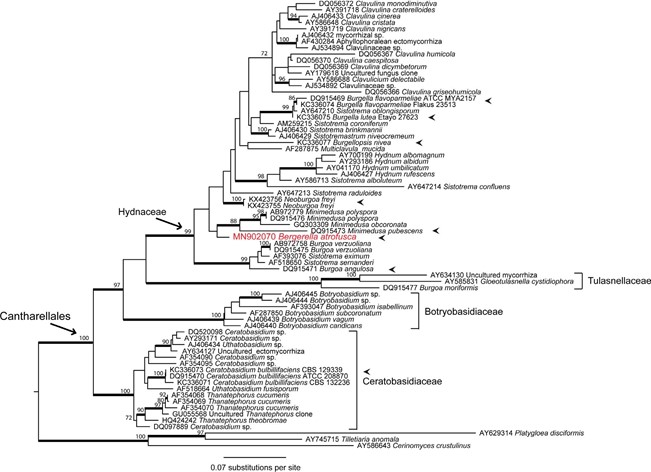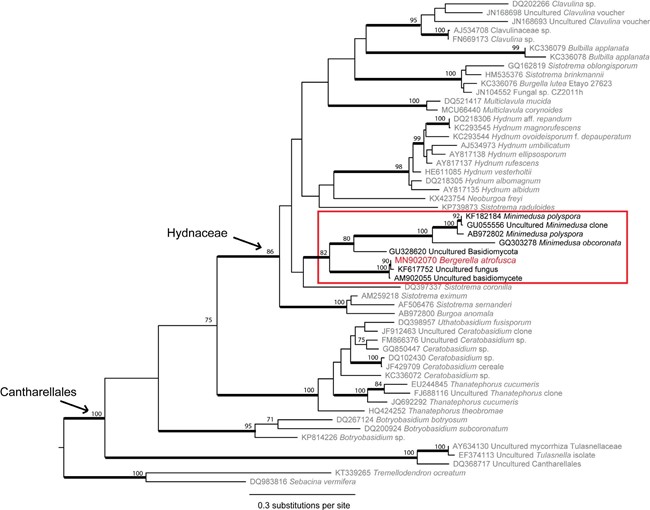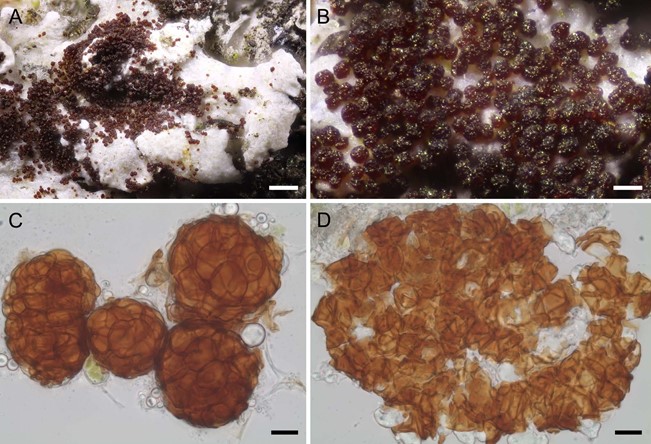Bergerella atrofusca Diederich & Lawrey, gen. et sp. nov. Figs. 1–3
MycoBank number: MB 835062; Index Fungorum number: IF 835062; Facesoffungi number: FoF;
Its Barcoding sequence accession: MN902070 (holotype)
Characterized by superficial, dark reddish brown, shiny, roundish to ellipsoid bulbils, (20–)25–35(– 45) lm diam., of roundish to ellipsoid, thin- walled cells, 6-15 lm diam.
Type: AUSTRIA. OSTTIROL: Matrei in Osttirol, Matreier Tauernhaus, 47º07’12″N, 12º29’36”E, 1510 m, on young Larix near river, on thallus of Physcia aipolia, 12 Sept. 2019, F. Berger 34240 (BR, holotype; HERB. BERGER, HERB. DIEDERICH, iso-types).
Description. Basidiomata and conidiomata un- known. Colonies appearing as dispersed or more often densely aggregated bulbils overgrowing thalli of Physcia species (Fig. 3A). Mycelium sparse around bulbils, hyaline, 3.5–5 lm diam. Bulbils (Fig. 3A–B) superficial from the beginning, dark reddish brown, shiny, without hairs, surface smooth, with individual cells indistinctly visible at a very high magnification, roundish to ellipsoid, (20–)25–35(–45) lm diam., externally without specialized cells, not covered by an amorphous layer (Fig. 3C), composed of more or less roundish to ellipsoid cells not separating easily (damaged with pressure on the cover glass, Fig. 3D), 6–15 lm diam.; cell wall thin, c. 0.5 lm thick; clamps not observed; content of cells colorless, with hyaline oil droplets emerging from slightly damaged bulbils when observed in water; no crystals visible in polarized light.
Distribution and ecology. The new species is known from two alpine localities in Austria, but is perhaps more widespread in the Alps as the host species are common there. It is known from thalli of Physcia aipolia and P. stellaris, in shaded, cool and humid conditions on a young Larix near a river and on dead Salix. Colonized thalli quickly become white and much thinner and eventually get reduced to a thin film of thallus remnants or disappear entirely. In the latter case, bulbils remain present on the bark of the tree and simulate a non-lichenicolous life. The fungus obviously represents a virulent pathogen of Physcia species and should easily be detected in the field by the dense agglomerations of dark brown bulbils contrasting with the necrosed thalli of the host.
Observations. Bergerella atrofusca is mainly characterized by the extremely small, dark reddish brown and shiny bulbils that develop superficially as a virulent pathogen on the thallus of Physcia species. All other known lichenicolous bulbilliferous fungi have larger bulbils, and all except Ceratobasidium bulbillifaciens are paler, ranging from white, ochraceous, honey-colored, yellow and orange to pink (Diederich et al. 2014). Bulbils of Ceratobasidium bulbillifaciens are grayish yellow to dark brown, matt, 100–200 lm in diam., internally composed of branched chains of cells (Diederich et al. 2014).
Etymology. The new genus is dedicated to our friend Franz Berger (Kopfing, Austria), an enthusiastic and passionate expert of lichenicolous fungi, and the collector of the new species. The diminutive suffix ’-ella’ designates the extremely small size of the bulbils of the new fungus. The epithet atrofusca refers to the dark brown bulbils.
Additional specimen examined: AUSTRIA.
Tyrol: Ö tztal, Vent, 46º51’19″N, 10º55’27″E, 1905m, on dead Salix, on Physcia stellaris, 14 Aug. 2018, E. Zimmermann, S. Feusi & F. Berger 33391 (HERB. BERGER).

Figure 1. Best-scoring nuLSU RAxML phylogram of species used in the analysis, showing the placement of Bergerella atrofusca. Internal branches in boldface indicate posterior probabilities ≥0.95 and numbers are ML-BS values ≥70. Arrow heads indicate described bulbilliferous species that are 6 lichenicolous.

Figure 2. Best-scoring ITS RAxML phylogram of species used in the analysis, showing the placement of Bergerella atrofusca. Focal taxa are in black font; others are in gray font. Internal branches in boldface indicate posterior probabilities ≥0.95 and numbers are ML-BS values ≥70.

Figure 3. Bergerella atrofusca (holotype, BR). A–B. Bulbils on white necrosed thallus of Physcia aipolia. C. Bulbils in water. D. Id., after pressure on cover glass. Scale bars: A¼200 lm, B¼50 lm, C––D¼10 lm.
